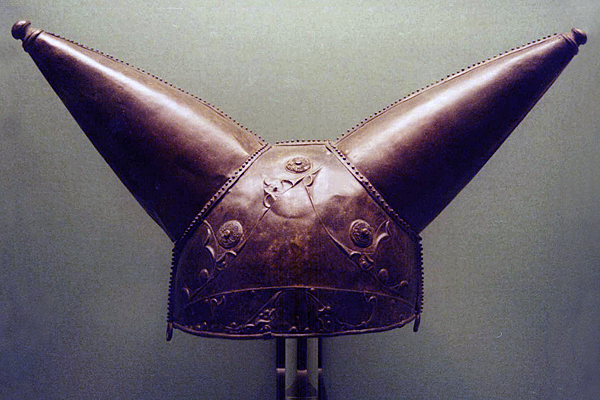
"On their heads they put bronze helmets which have large embossed figures standing out from them and give an appearance of great size to those who wear them; for in some cases horns are attached to the helmet so as to form a single piece, in other cases images of the fore-parts of birds or four-footed animals"
Cassius Dio, Roman History (V.30.2)
At the beginning of the third century AD, Cassius Dio comments on the British warrior. "They go into battle in chariots, and have small, swift horses; there are also foot-soldiers, very swift in running and very firm in standing their ground. For arms they have a shield and a short spear, with a bronze apple attached to the end of the spear-shaft, so that when it is shaken it may clash and terrify the enemy; and they also have daggers" (LXXVII.12.3). But such weapons put the Britons at a disadvantage. Their "small shields and enormous swords—for the swords of the Britons, having no points, were unsuited for a cut-and-thrust struggle and close-quarters battle" (XXXVI). Of course, the disciplined Roman legionary excelled at such combat. In place of the short gladius, Diodorus reports that the Gauls carry long broad-swords worn on the right and suspended from a chain. Indeed, "their swords are not shorter than the javelins of other peoples, and the heads of their javelins are larger than the swords of others" (V.30.2-4). Their shields are equally large, "as high as a man" and beautifully wrought with figures of animals.
The bronze helmet dates from 150-50 BC and is in the British Museum. Found in the River Thames in the early 1860s, it is the only iron-age helmet to have been discovered in southern England and the only one with horns in all of Europe. The repoussé figures and studs of red glass with which it originally was decorated suggest that it was a symbolic head-dress and not worn in battle.
References: Dio Cassius: Roman History (1914-) translated by Earnest Cary and Herbert B. Foster (Loeb Classical Library); Diodorus Siculus: Library of History (1954) translated by Russel M. Geer (Loeb Classical Library).